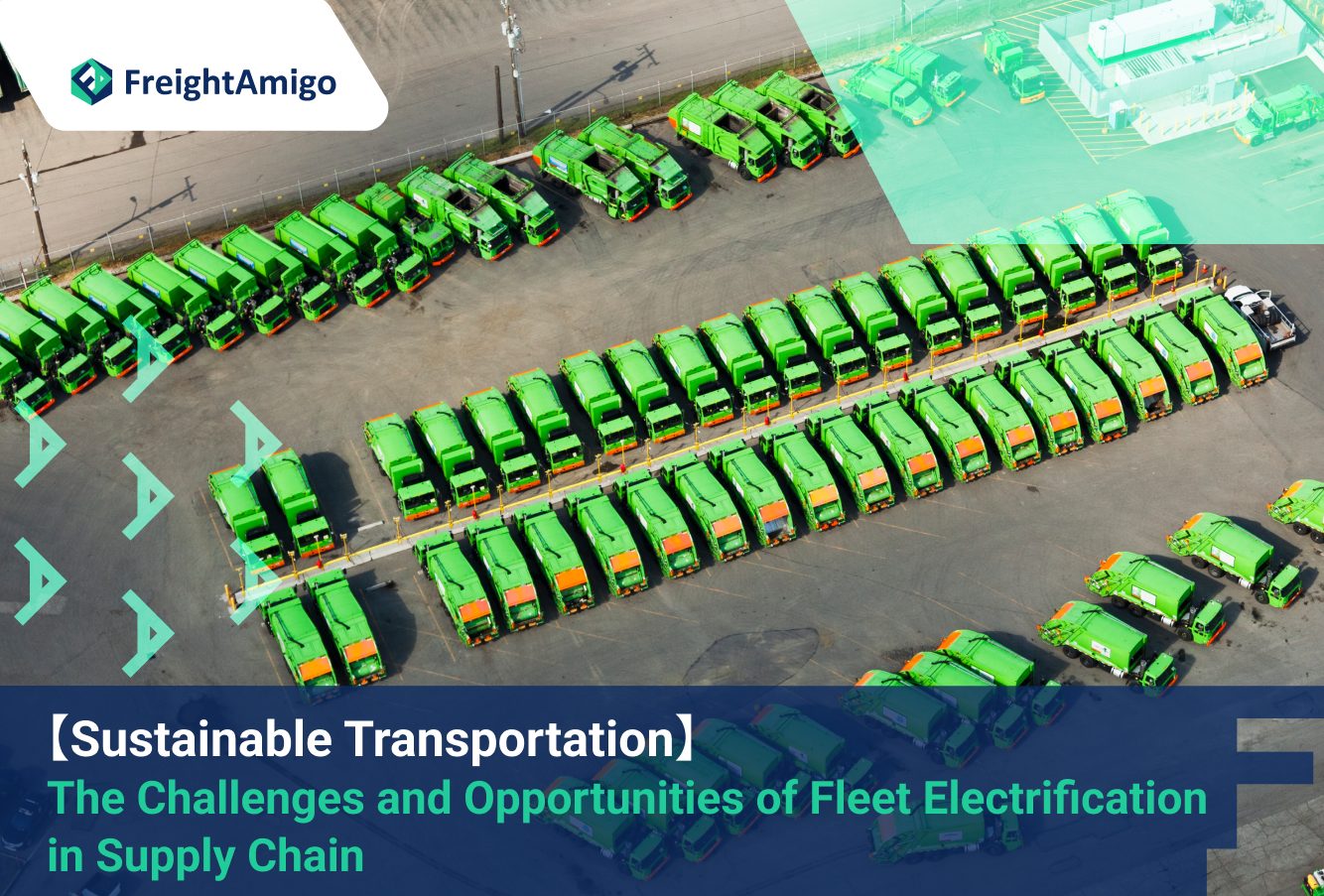January 10th, 2024: Maya Wong – Marketing Analyst at FreightAmigo
As the world becomes increasingly focused on sustainability and reducing carbon emissions, fleet electrification has emerged as a key solution for the transportation industry. With the potential to significantly reduce greenhouse gas emissions and improve air quality, electric vehicles (EVs) are gaining traction in various sectors, including supply chain and logistics. However, fleet electrification also presents several challenges that need to be addressed for widespread adoption. In this article, we will explore the challenges and opportunities of fleet electrification in the context of the supply chain industry.
Want To Compare The Best Express, Air Freight, Sea Freight, Rail Freight & Trucking Rates So As To Have Better Control On Cost?
The Challenge of Limited EV Range
One of the primary challenges of fleet electrification is the limited range of electric vehicles compared to their traditional gasoline or diesel counterparts. While EV technology has significantly improved over the years, the range of electric trucks is still not comparable to that of diesel trucks. For example, a diesel truck can travel up to 1,000 kilometers between fuel stops, while an electric truck may have a maximum range of around 300 kilometers. This limited range poses a challenge for long-haul delivery operations where making fewer stops is crucial for timely deliveries and customer satisfaction.
To overcome this challenge, fleet operators need to carefully plan their routes and ensure access to charging infrastructure along the way. By optimizing routes and strategically placing charging stations, fleet managers can minimize downtime and ensure efficient operations. Additionally, advancements in battery technology, such as improved energy density and faster charging capabilities, will further extend the range of electric trucks and make fleet electrification more feasible for long-haul logistics.
Charging Infrastructure and Route Optimization
Another challenge of fleet electrification is the availability and distribution of charging infrastructure. While there are nearly 43,000 public charging stations in the United States, their distribution is uneven, with California having almost as many stations as 39 other states combined. Designing efficient routes that allow trucks to make deliveries while also accessing charging stations requires extensive planning and coordination.
To address this challenge, fleet operators can leverage technology-based route optimization solutions. Artificial intelligence (AI) algorithms can analyze multiple factors, including charging locations and vehicle ranges, to plan the most efficient paths for electric vehicles. By integrating real-time data on charging station availability and traffic conditions, fleet managers can optimize routes to minimize downtime and ensure seamless operations.
Furthermore, the deployment of fast-charging infrastructure is crucial to enable quick charging stops and minimize disruptions. While the installation cost of fast chargers can be high, government incentives and collaborations with charging infrastructure providers can help reduce the financial burden for fleet operators. Increased investment in charging infrastructure, especially in rural and low-income areas, will also improve accessibility and support the growth of fleet electrification.
Limited Supply of Electric Trucks
The limited supply of electric trucks is another significant challenge for fleet electrification. While the market for electric trucks is expanding, automakers currently do not produce enough electric trucks to meet the growing demand. This high demand, coupled with constraints in the EV battery supply chain, creates bottlenecks and delays in the availability of electric trucks.
To address this challenge, automakers need to ramp up production and invest in expanding their electric truck manufacturing capabilities. Collaboration between automakers and fleet operators can help prioritize the production and delivery of electric trucks to meet the increasing demand. Government support in the form of incentives and subsidies can also encourage automakers to scale up their production of electric trucks.
Furthermore, advancements in battery technology and the availability of critical battery raw materials, such as lithium, nickel, and cobalt, will play a crucial role in increasing the supply of electric trucks. Recycling programs for EV batteries can also help reduce the demand for new battery production and ensure a sustainable supply chain for electric vehicles.
High Upfront Costs and Return on Investment
One of the major obstacles to fleet electrification is the high upfront costs of electric trucks compared to their diesel counterparts. Electric trucks typically have higher purchase prices due to the cost of batteries and other components. This can be a deterrent for fleet operators, especially smaller companies with limited budgets.
However, it is important to consider the total cost of ownership over the lifetime of the vehicle. While electric trucks have higher upfront costs, they have lower operating and maintenance costs compared to diesel trucks. Electric trucks require less maintenance due to fewer moving parts and lower fuel costs, resulting in potential long-term savings for fleet operators.
To overcome the challenge of high upfront costs, fleet operators can explore financial incentives, grants, and subsidies offered by governments and utility companies. These financial incentives can help offset the initial investment and make fleet electrification more financially viable. Additionally, leasing options and partnerships with charging infrastructure providers can help reduce upfront costs and provide a more affordable entry point for fleet operators.
Unfamiliarity and Change Management
The unfamiliarity with electric vehicles and the need for change management pose challenges for fleet electrification. Many fleet operators may be hesitant to adopt electric trucks due to concerns about the newness of the technology and the potential disruption to their operations. The transition from traditional fueling stations to charging stations requires a shift in mindset and operational processes.
To address this challenge, fleet operators need to invest in employee education and training programs to familiarize drivers, mechanics, and other staff with electric vehicle technology. Providing comprehensive information about the benefits of electric trucks, such as reduced emissions and lower operating costs, can help overcome resistance and gain buy-in from employees.
Change management strategies, such as pilot programs and phased implementation, can also help ease the transition to fleet electrification. By starting with a small number of electric trucks and gradually expanding the fleet, operators can identify and address any operational challenges or concerns early on. This approach allows for a smoother transition and minimizes disruptions to daily operations.
Opportunities for Fleet Electrification
While fleet electrification presents various challenges, it also offers significant opportunities for the supply chain industry. Embracing electric trucks and transitioning to a greener fleet can bring several benefits for fleet operators, the environment, and society as a whole.
Environmental Sustainability
One of the key opportunities of fleet electrification is the potential to significantly reduce greenhouse gas emissions and improve air quality. Electric trucks produce zero tailpipe emissions, resulting in cleaner air and a healthier environment. By transitioning to electric trucks, fleet operators can contribute to global efforts to mitigate climate change and reduce dependence on fossil fuels.
Cost Savings and Operational Efficiency
Despite the higher upfront costs, electric trucks can offer long-term cost savings and operational efficiency for fleet operators. Electric trucks have lower maintenance costs due to fewer moving parts and reduced reliance on expensive diesel fuel. With the availability of financial incentives and grants, fleet operators can offset the initial investment and achieve a positive return on investment over time.
Regulatory Compliance and Corporate Social Responsibility
As governments around the world implement stricter emissions regulations, fleet electrification can help fleet operators comply with these regulations and avoid potential penalties. Electric trucks align with corporate social responsibility goals and demonstrate a commitment to sustainability, which can enhance a company’s reputation and attract environmentally conscious customers.
Improved Customer Experience and Competitive Advantage
Fleet electrification can also lead to an improved customer experience and a competitive advantage in the market. Electric trucks are quieter and produce less vibration than diesel trucks, resulting in a more pleasant delivery experience for customers. Additionally, with the increasing demand for sustainable transportation solutions, companies that embrace fleet electrification can differentiate themselves from competitors and attract environmentally conscious customers.
Innovation and Technology Leadership
By adopting electric trucks, fleet operators can position themselves as leaders in innovation and technology. Embracing new technologies and sustainable transportation solutions demonstrates a forward-thinking approach and a commitment to driving positive change in the industry. This can attract partnerships, collaborations, and investment opportunities from organizations that value sustainability and technological advancements.
Conclusion
Fleet electrification in the supply chain industry presents both challenges and opportunities. While limited EV range, charging infrastructure, limited supply of electric trucks, high upfront costs, and unfamiliarity pose obstacles, advancements in technology, government support, and changing market dynamics offer opportunities for fleet operators. By addressing these challenges through strategic planning, collaboration, and investment in sustainable solutions, fleet operators can transition to a greener fleet, reduce emissions, and contribute to a more sustainable future. With the right mindset, knowledge, and support, fleet electrification can drive positive change in the supply chain.
There Are Different Options For Cargo Transportation. If You Want To Choose The Most Convenient And Suitable Solution, It Is Best To Have The Full Support Of Logistics Experts! If You Are Planning To Ship Goods Overseas, Please Go To The FreightAmigo Page For Inquiries.
===
Read More:
【Sustainable Logistics】 The New Green Dawn in the Logistics Industry
【Rise of Green Supply Chain】 Pioneering Sustainable Practices in Logistics
【Embracing Renewable Energy】 A Green Shift in Logistics
===
If you have any inquiries on logistics/supply chain, feel free to contact FreightAmigo now:
Chat with us online OR
Phone : +852 28121686
WhatsApp: +852 27467829









































